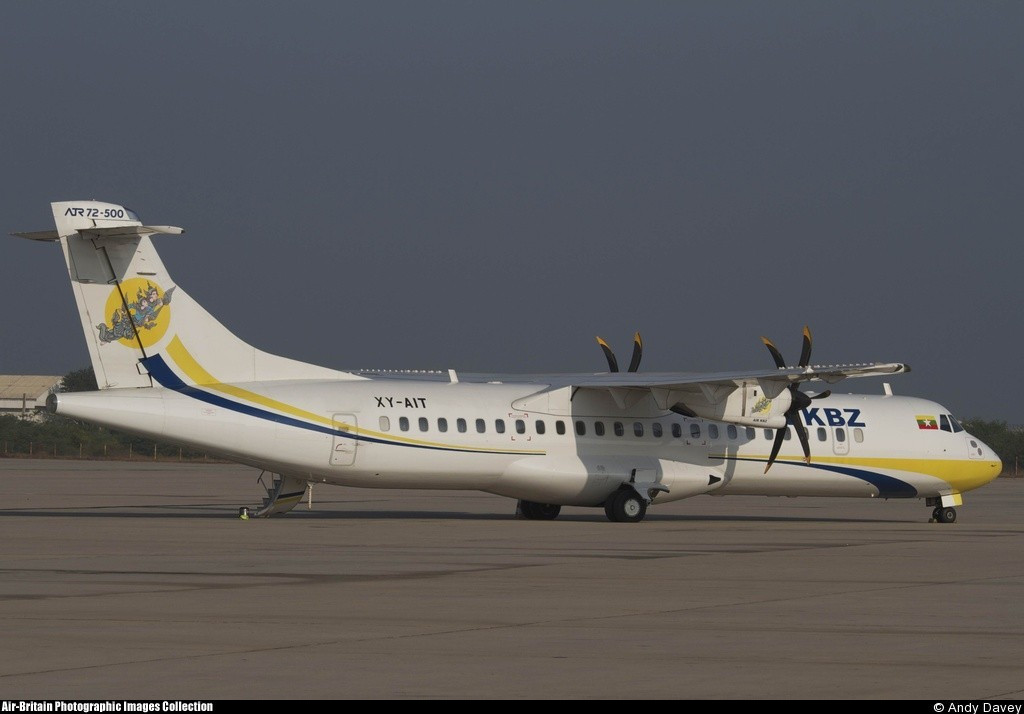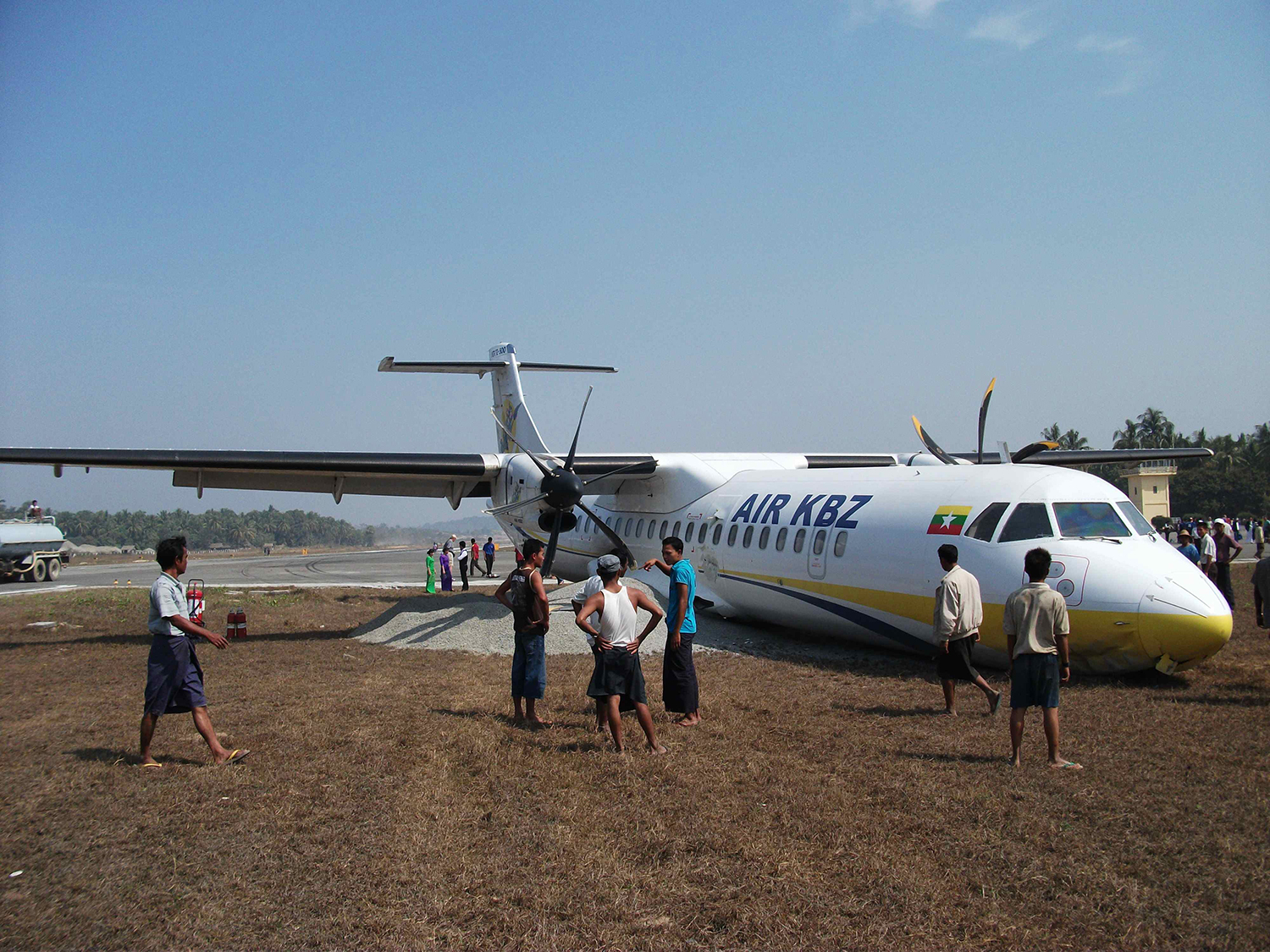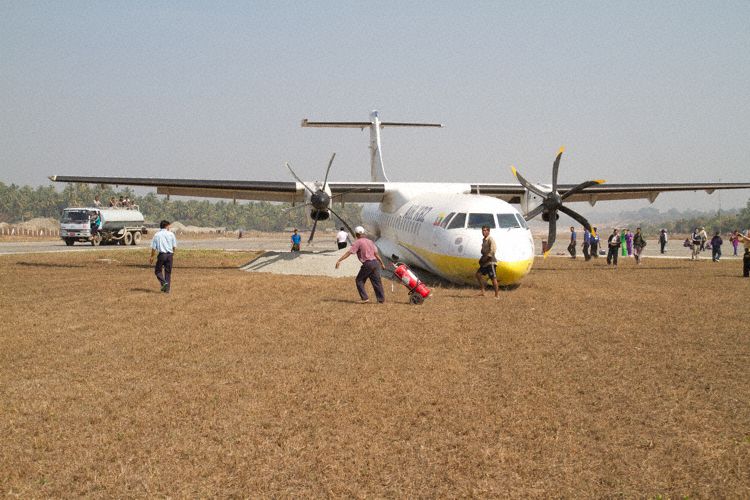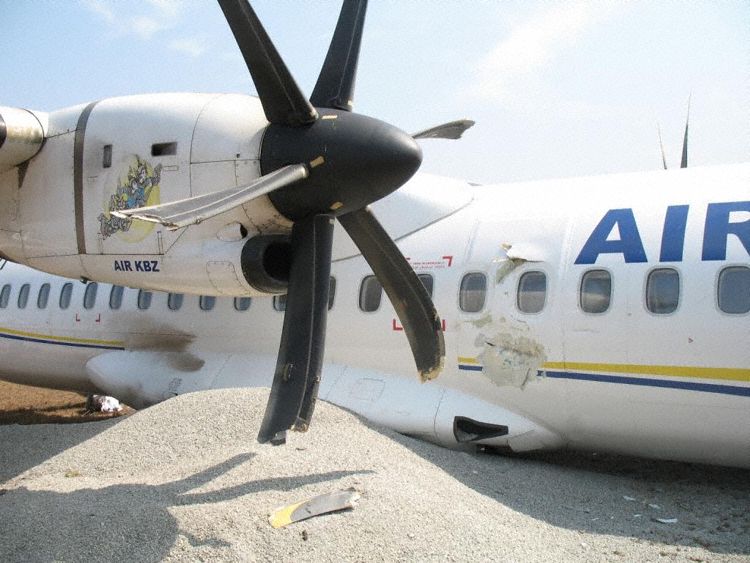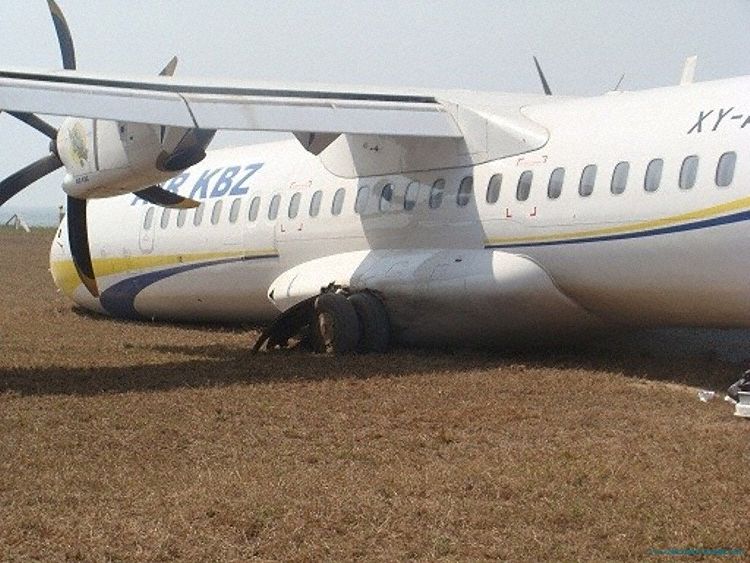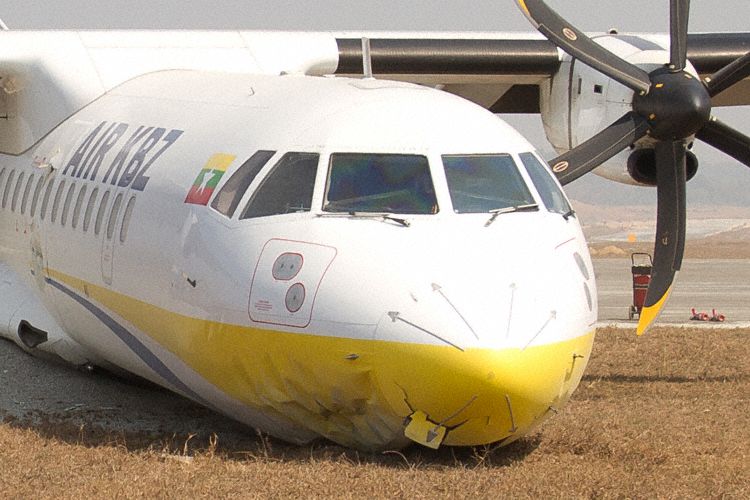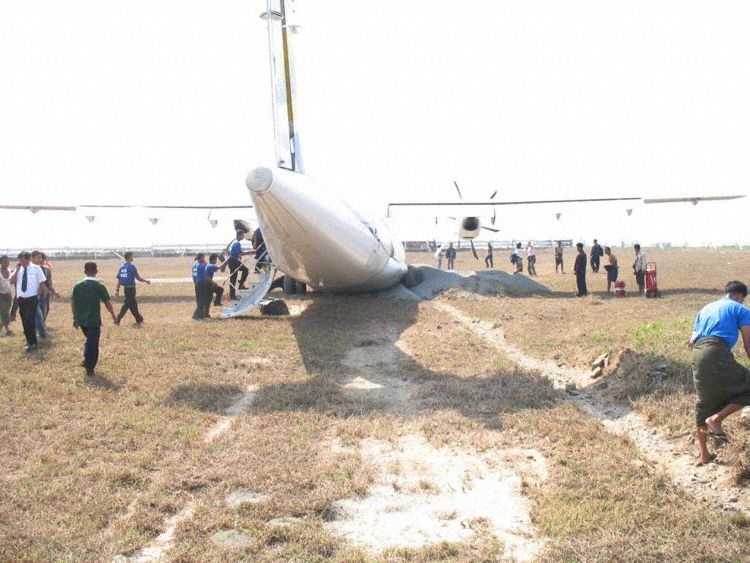Country
Ground collision with an ATR72-500 in Medan
Date & Time:
Aug 3, 2017 at 1100 LT
Registration:
PK-WFF
Survivors:
Yes
Schedule:
Medan – Meulaboh
MSN:
869
YOM:
2009
Flight number:
IW1252
Crew on board:
5
Crew fatalities:
Pax on board:
67
Pax fatalities:
Other fatalities:
Total fatalities:
0
Captain / Total hours on type:
624.00
Copilot / Total hours on type:
109
Aircraft flight hours:
14321
Aircraft flight cycles:
16132
Circumstances:
On 3 August 2017, a Boeing 737-900 ER aircraft, operated by PT. Lion Mentari Airlines (Lion Air) as a scheduled passenger flight from Sultan Iskandar Muda International Airport, Banda Aceh (WITT) to Kualanamu International Airport, Medan (WIMM) as flight number JT 197. JT197 departed at 1010 LT (0310 UTC) in daylight condition, with 151 persons on board. Meanwhile, an ATR 72-500 aircraft, operated by PT. Wings Abadi Airlines (Wings Air) as scheduled passenger flight from Medan with intended destination to Cut Nyak Dien Airport, Meulaboh (WITC) as flight number IW1252. On board IW1252 were two pilots, one observer pilot, two flight attendants and 67 passengers. At 0356 UTC, the IW1252 pilot requested taxi clearance to runway 23 from the Medan Ground controller and was instructed to follow U2 taxi route, the IW1252 pilot requested to depart via intersection taxiway D which was approved by Medan Tower controller. At 0357 UTC, JT197 was on landing approach and received landing clearance. At 04:00:01 UTC, the Medan Tower controller issued conditional clearance to the IW1252 pilot, to enter the runway after the JT197 had landed. This conditional clearance was combined with the air traffic control route clearance. IW1252 continued to taxi and entered the runway. At 04:00:50 UTC, JT197 touched down on runway 23 and a few second later impacted with the IW1252. There were no injuries during this occurrence, but both aircraft were substantially damaged. After impact, debris from the impact aircraft remained on the runway. Prior to the runway inspection, one aircraft departed and one aircraft landed.
Probable cause:
The communication misunderstanding of the conditional clearance to enter runway while the IW1252 pilots did not aware of JT197 had received landing clearance and the unobserved IW1252 aircraft movement made the IW1252 aircraft entered the runway.
Final Report:
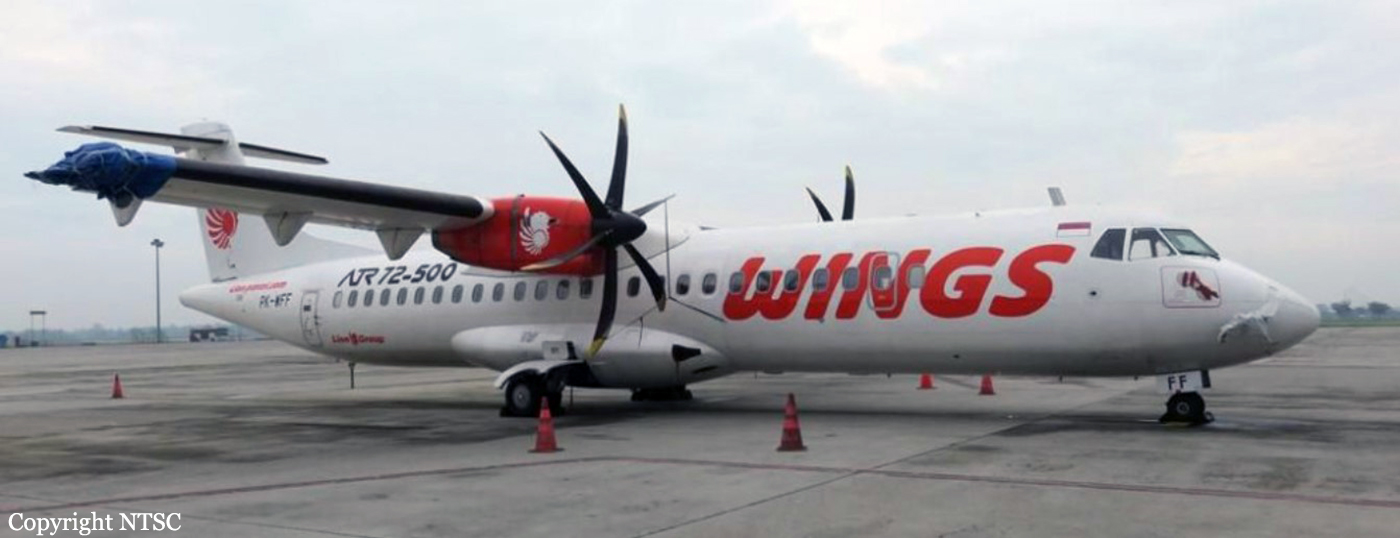
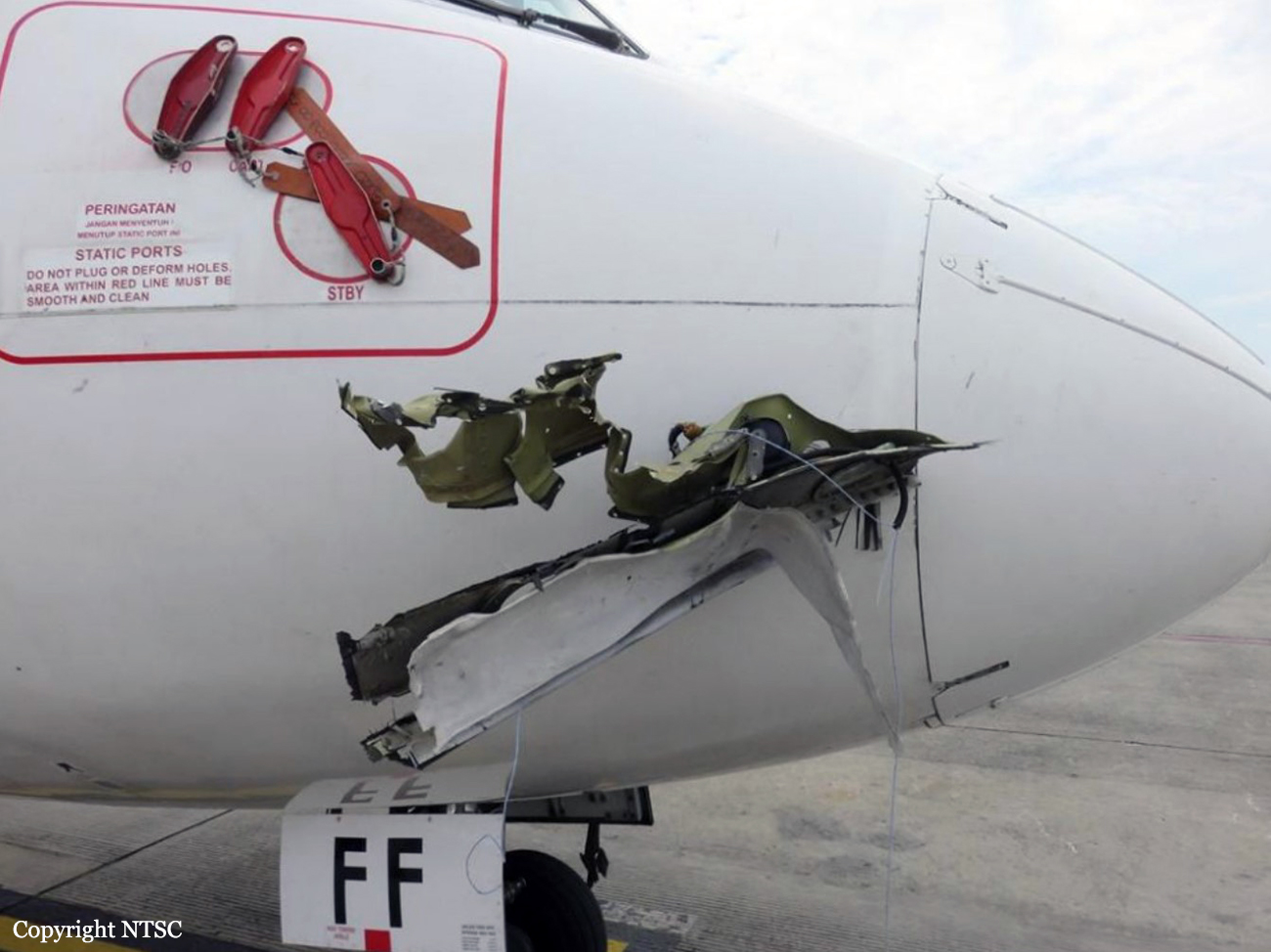
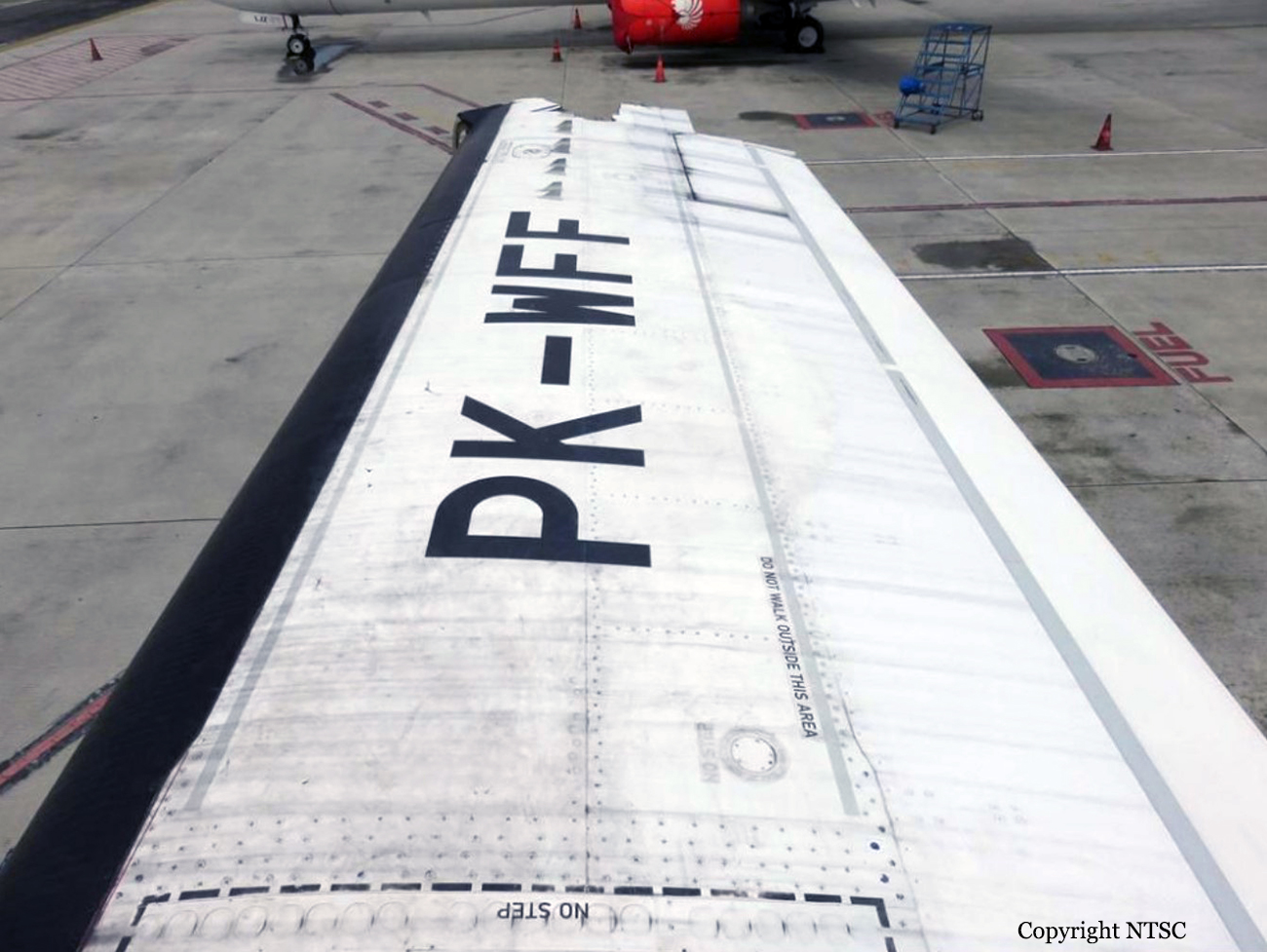
Crash of an ATR72-500 in Magong: 48 killed
Date & Time:
Jul 23, 2014 at 1906 LT
Registration:
B-22810
Survivors:
Yes
Schedule:
Kaohsiung – Magong
MSN:
642
YOM:
2000
Flight number:
GE222
Crew on board:
4
Crew fatalities:
Pax on board:
54
Pax fatalities:
Other fatalities:
Total fatalities:
48
Captain / Total hours on type:
19069.00
Copilot / Total hours on type:
2083
Aircraft flight hours:
27039
Aircraft flight cycles:
40387
Circumstances:
The aircraft was being operated on an instrument flight rules (IFR) regular public transport service from Kaohsiung to Magong in the Penghu archipelago. At 1906 Taipei Local Time, the aircraft impacted terrain approximately 850 meters northeast of the threshold of runway 20 at Magong Airport and then collided with a residential area on the outskirts of Xixi village approximately 200 meters to the southeast of the initial impact zone. At the time of the occurrence, the crew was conducting a very high frequency omni-directional radio range (VOR) non-precision approach to runway 20. The aircraft was destroyed by impact forces and a post-impact fire. Ten passengers survived the occurrence and five residents on the ground sustained minor injuries. The occurrence was the result of controlled flight into terrain, that is, an airworthy aircraft under the control of the flight crew was flown unintentionally into terrain with limited awareness by the crew of the aircraft’s proximity to terrain. The crew continued the approach below the minimum descent altitude (MDA) when they were not visual with the runway environment contrary to standard operating procedures. The investigation report identified a range of contributing and other safety factors relating to the flight crew of the aircraft, TransAsia’s flight operations and safety management processes, the communication of weather information to the flight crew, coordination issues at civil/military joint-use airport, and the regulatory oversight of TransAsia by the Civil Aeronautics Administration (CAA).
Probable cause:
- The flight crew did not comply with the published runway 20 VOR non-precision instrument approach procedures at Magong Airport with respect to the minimum descent altitude (MDA). The captain, as the pilot flying, intentionally descended the aircraft below the published MDA of 330 feet in the instrument meteorological conditions (IMC) without obtaining the required visual references.
- The aircraft maintained an altitude between 168 and 192 feet before and just after overflying the missed approach point (MAPt). Both pilots spent about 13 seconds attempting to visually locate the runway environment, rather than commencing a missed approach at or prior to the MAPt as required by the published procedures.
- As the aircraft descended below the minimum descent altitude (MDA), it diverted to the left of the inbound instrument approach track and its rate of descent increased as a result of the flying pilot’s control inputs and meteorological conditions. The aircraft’s hazardous flight path was not detected and corrected by the crew in due time to avoid the collision with the terrain, suggesting that the crew lost situational awareness about the aircraft’s position during the latter stages of the approach.
- During the final approach, the heavy rain and associated thunderstorm activity intensified producing a maximum rainfall of 1.8 mm per minute. The runway visual range (RVR) subsequently reduced to approximately 500 meters. The degraded visibility significantly reduced the likelihood that the flight crew could have acquired the visual references to the runway environment during the approach.
- Flight crew coordination, communication, and threat and error management were less than effective. That compromised the safety of the flight. The first officer did not comment about or challenge the fact that the captain had intentionally descended the aircraft below the published minimum descent altitude (MDA). Rather, the first officer collaborated with the captain’s intentional descent below the MDA. In addition, the first officer did not detect the aircraft had deviated from the published inbound instrument approach track or identify that those factors increased the risk of a controlled flight into terrain (CFIT) event.
- None of the flight crew recognized the need for a missed approach until the aircraft reached the point (72 feet, 0.5 nautical mile beyond the missed approach point) where collision with the terrain became unavoidable.
- The aircraft was under the control of the flight crew when it collided with foliage 850 meters northeast of the runway 20 threshold, two seconds after the go around decision had been made. The aircraft sustained significant damage and subsequently collided with buildings in a residential area. Due to the high impact forces and post-impact fire, the crew and most passengers perished.
- According to the flight recorders data, non-compliance with standard operating procedures (SOP's) was a repeated practice during the occurrence flight. The crew’s recurring non-compliance with SOP's constituted an operating culture in which high risk practices were routine and considered normal.
- The non-compliance with standard operating procedures (SOP's) breached the obstacle clearances of the published procedure, bypassed the safety criteria and risk controls considered in the design of the published procedures, and increased the risk of a controlled flight into terrain (CFIT) event.
- The aircraft maintained an altitude between 168 and 192 feet before and just after overflying the missed approach point (MAPt). Both pilots spent about 13 seconds attempting to visually locate the runway environment, rather than commencing a missed approach at or prior to the MAPt as required by the published procedures.
- As the aircraft descended below the minimum descent altitude (MDA), it diverted to the left of the inbound instrument approach track and its rate of descent increased as a result of the flying pilot’s control inputs and meteorological conditions. The aircraft’s hazardous flight path was not detected and corrected by the crew in due time to avoid the collision with the terrain, suggesting that the crew lost situational awareness about the aircraft’s position during the latter stages of the approach.
- During the final approach, the heavy rain and associated thunderstorm activity intensified producing a maximum rainfall of 1.8 mm per minute. The runway visual range (RVR) subsequently reduced to approximately 500 meters. The degraded visibility significantly reduced the likelihood that the flight crew could have acquired the visual references to the runway environment during the approach.
- Flight crew coordination, communication, and threat and error management were less than effective. That compromised the safety of the flight. The first officer did not comment about or challenge the fact that the captain had intentionally descended the aircraft below the published minimum descent altitude (MDA). Rather, the first officer collaborated with the captain’s intentional descent below the MDA. In addition, the first officer did not detect the aircraft had deviated from the published inbound instrument approach track or identify that those factors increased the risk of a controlled flight into terrain (CFIT) event.
- None of the flight crew recognized the need for a missed approach until the aircraft reached the point (72 feet, 0.5 nautical mile beyond the missed approach point) where collision with the terrain became unavoidable.
- The aircraft was under the control of the flight crew when it collided with foliage 850 meters northeast of the runway 20 threshold, two seconds after the go around decision had been made. The aircraft sustained significant damage and subsequently collided with buildings in a residential area. Due to the high impact forces and post-impact fire, the crew and most passengers perished.
- According to the flight recorders data, non-compliance with standard operating procedures (SOP's) was a repeated practice during the occurrence flight. The crew’s recurring non-compliance with SOP's constituted an operating culture in which high risk practices were routine and considered normal.
- The non-compliance with standard operating procedures (SOP's) breached the obstacle clearances of the published procedure, bypassed the safety criteria and risk controls considered in the design of the published procedures, and increased the risk of a controlled flight into terrain (CFIT) event.
Final Report:
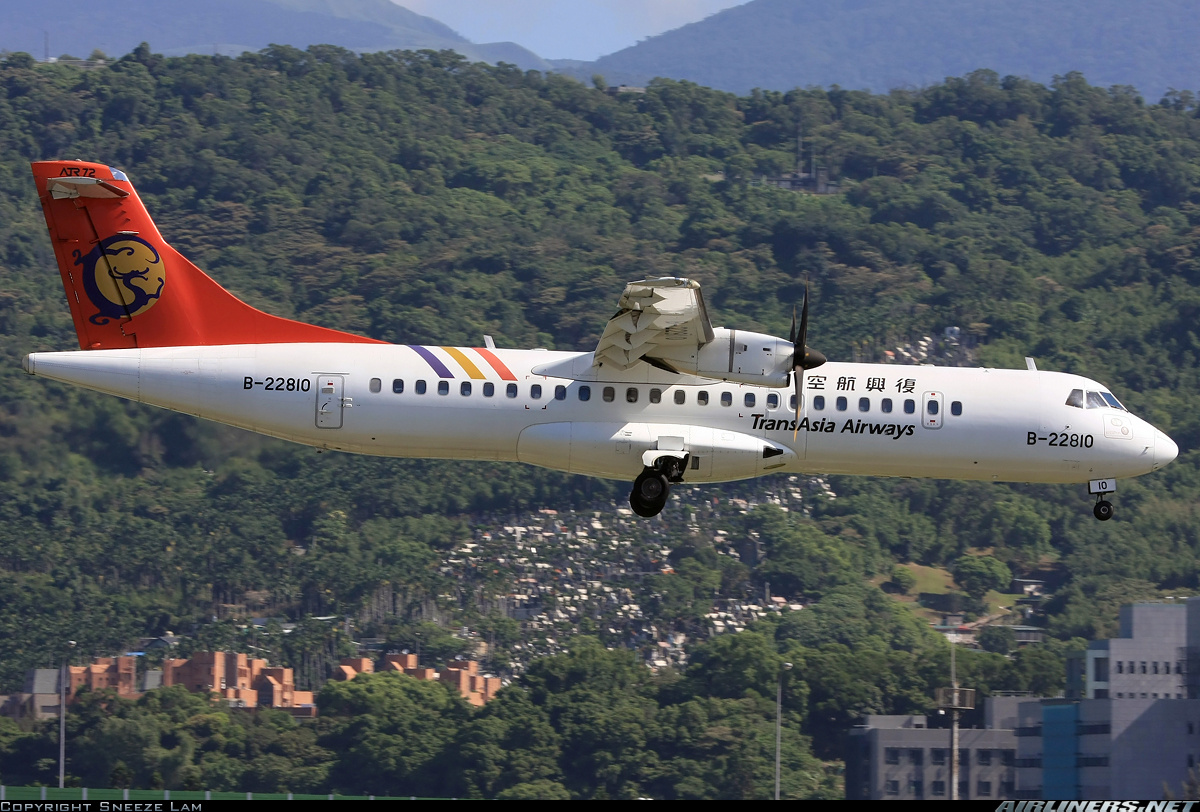

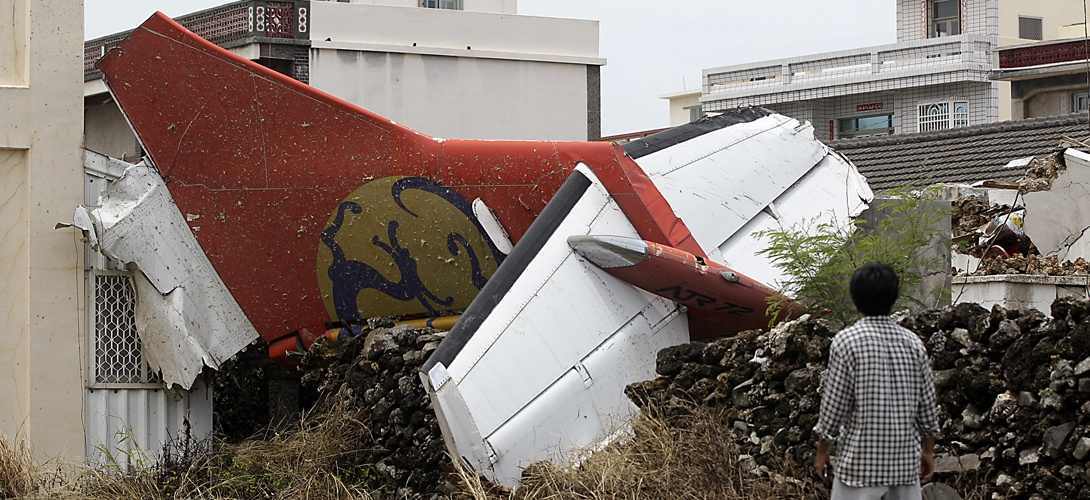
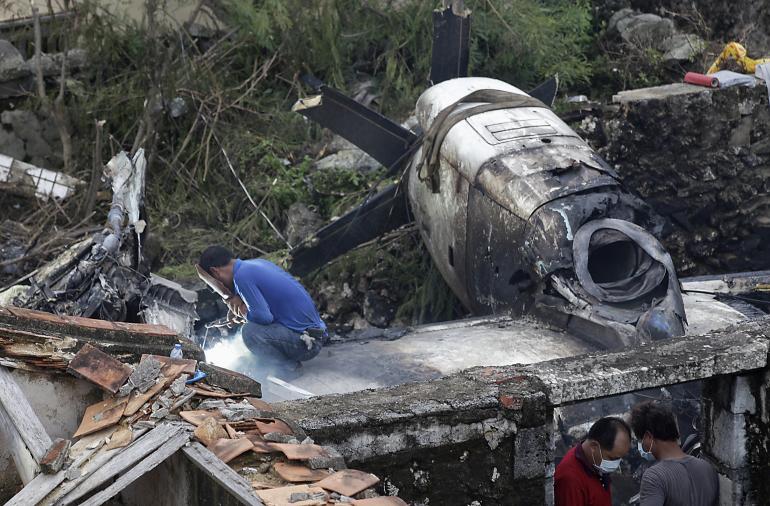
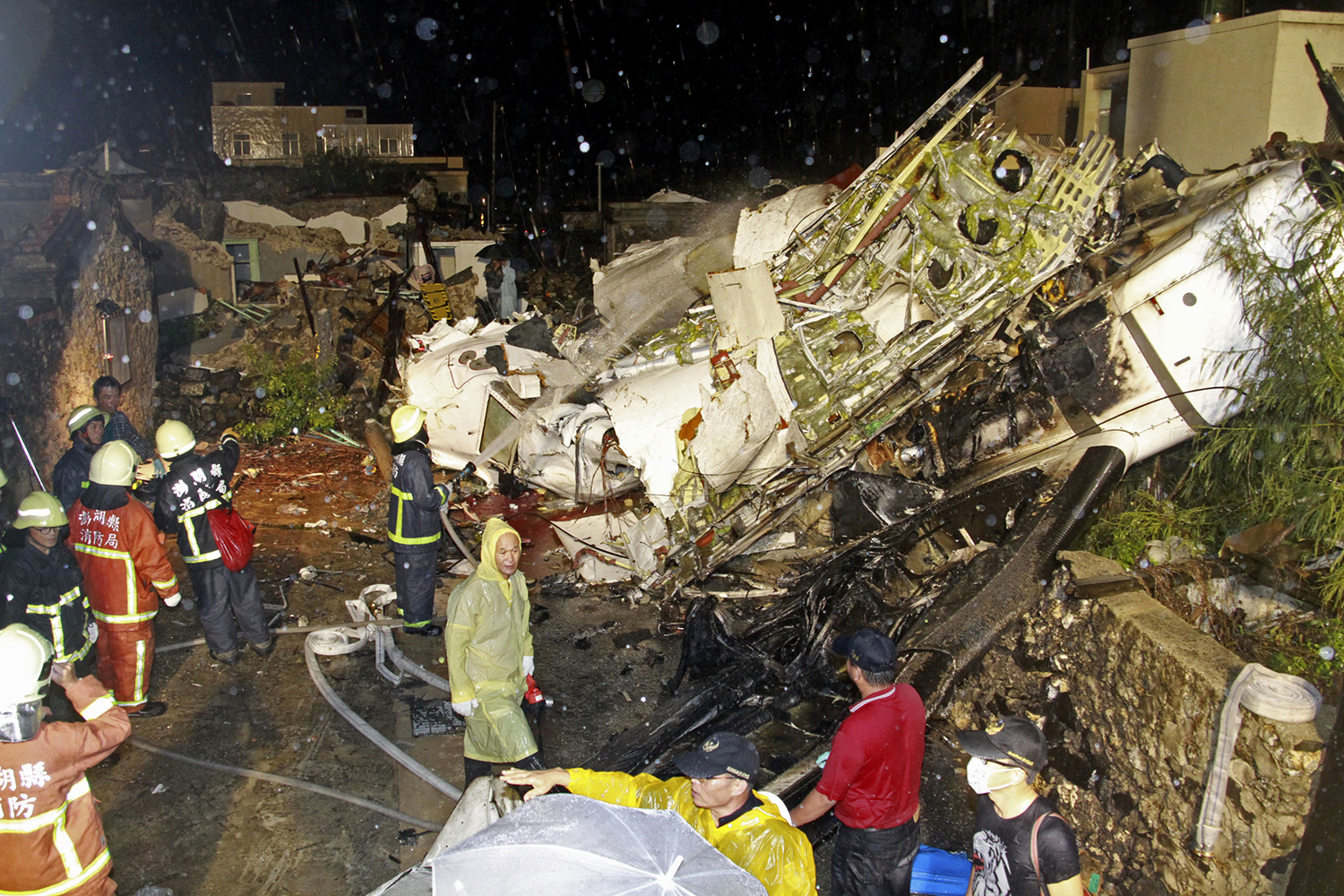
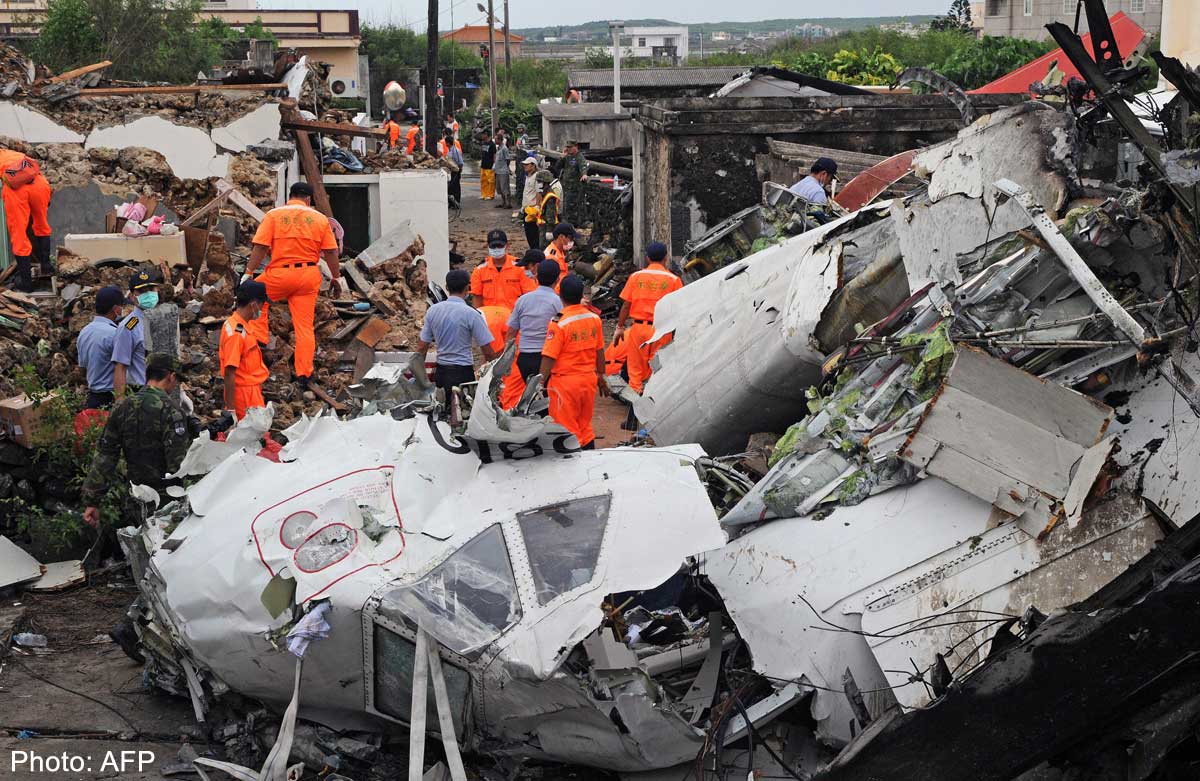
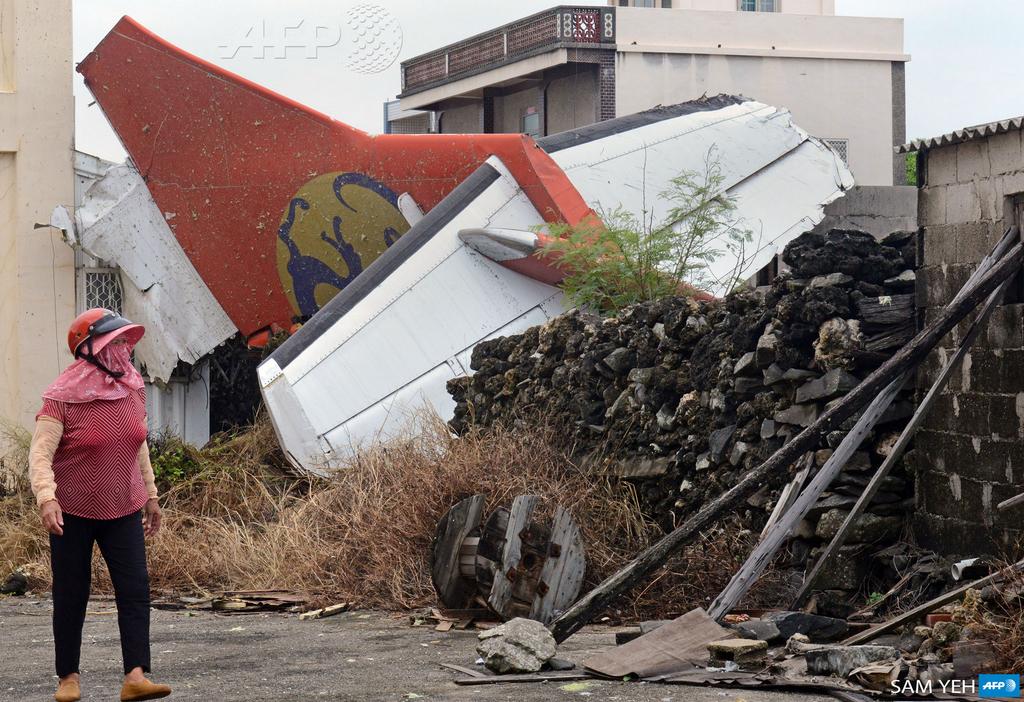
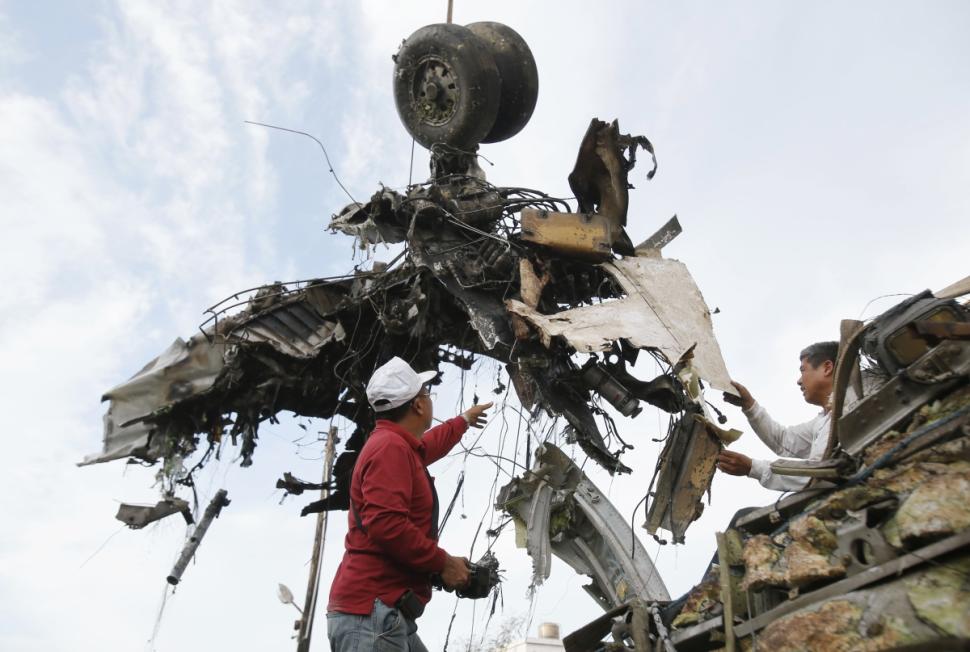
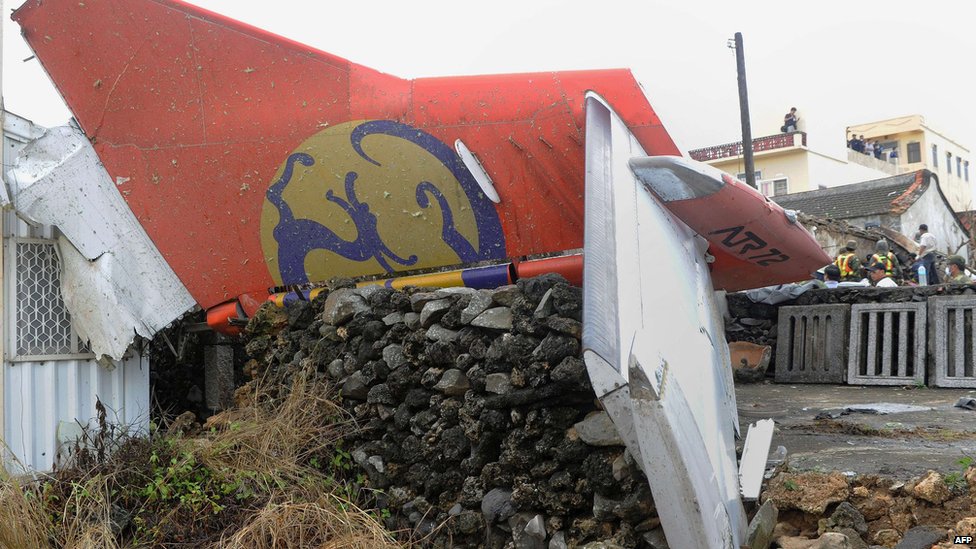
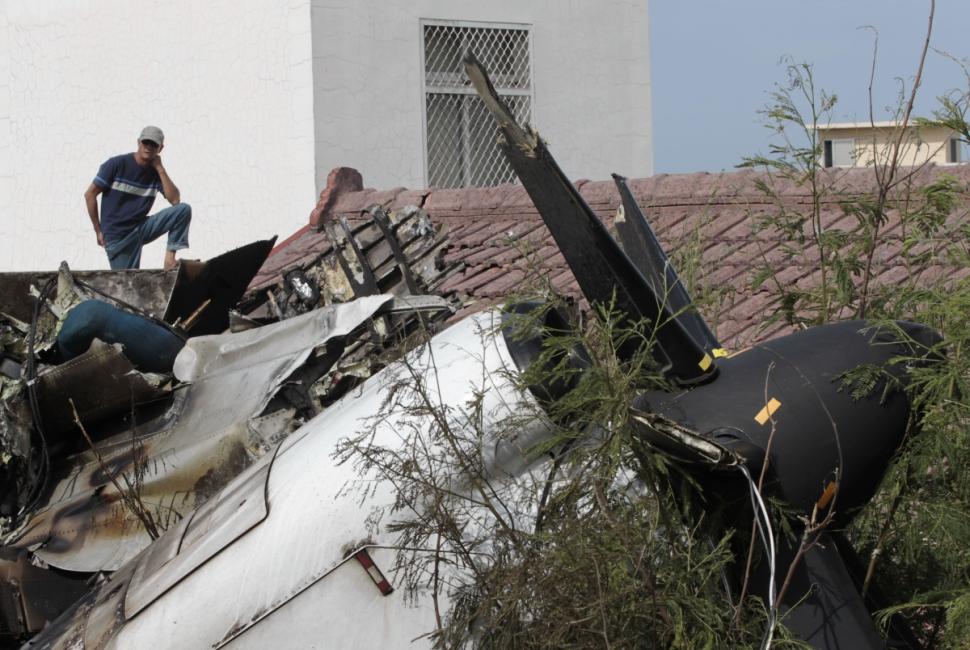
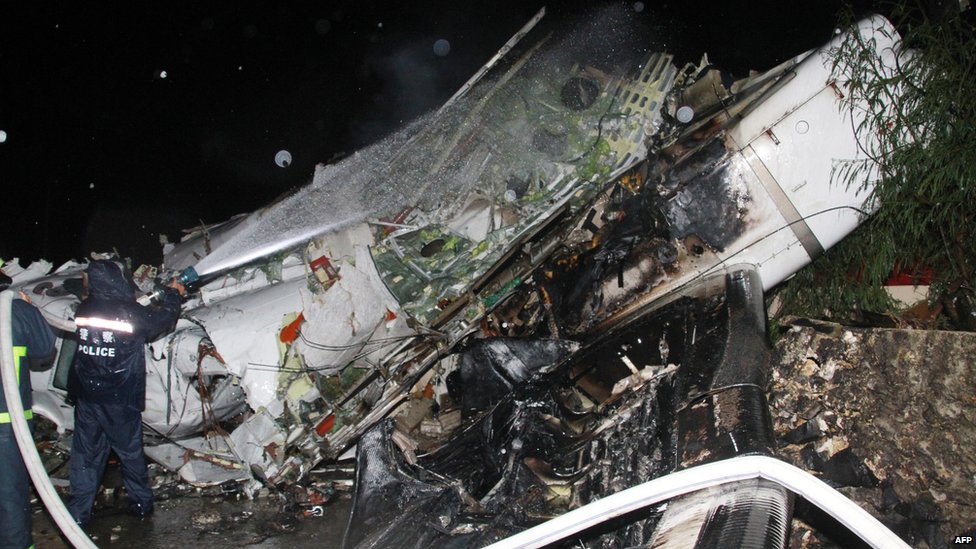
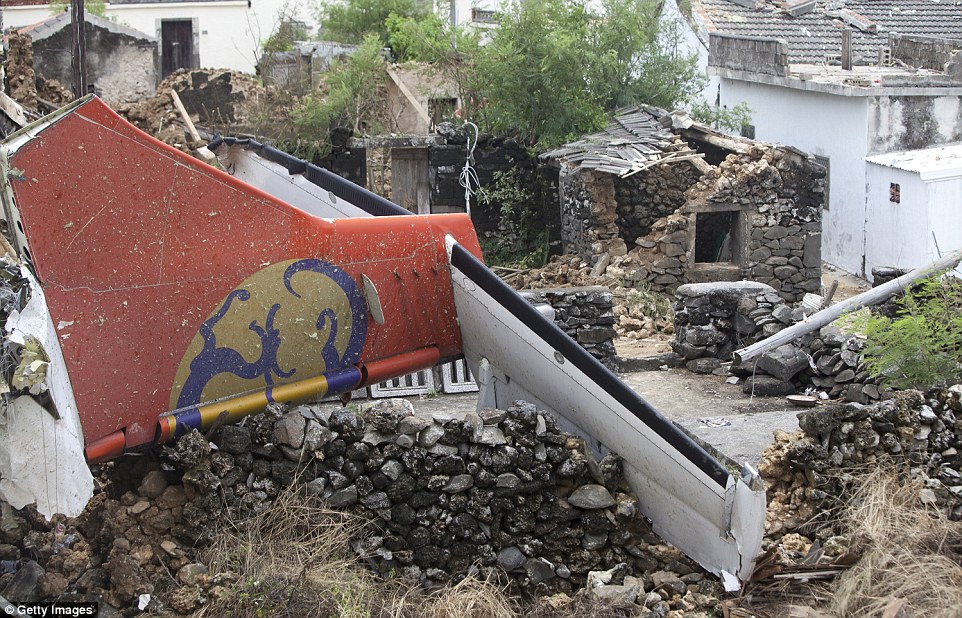
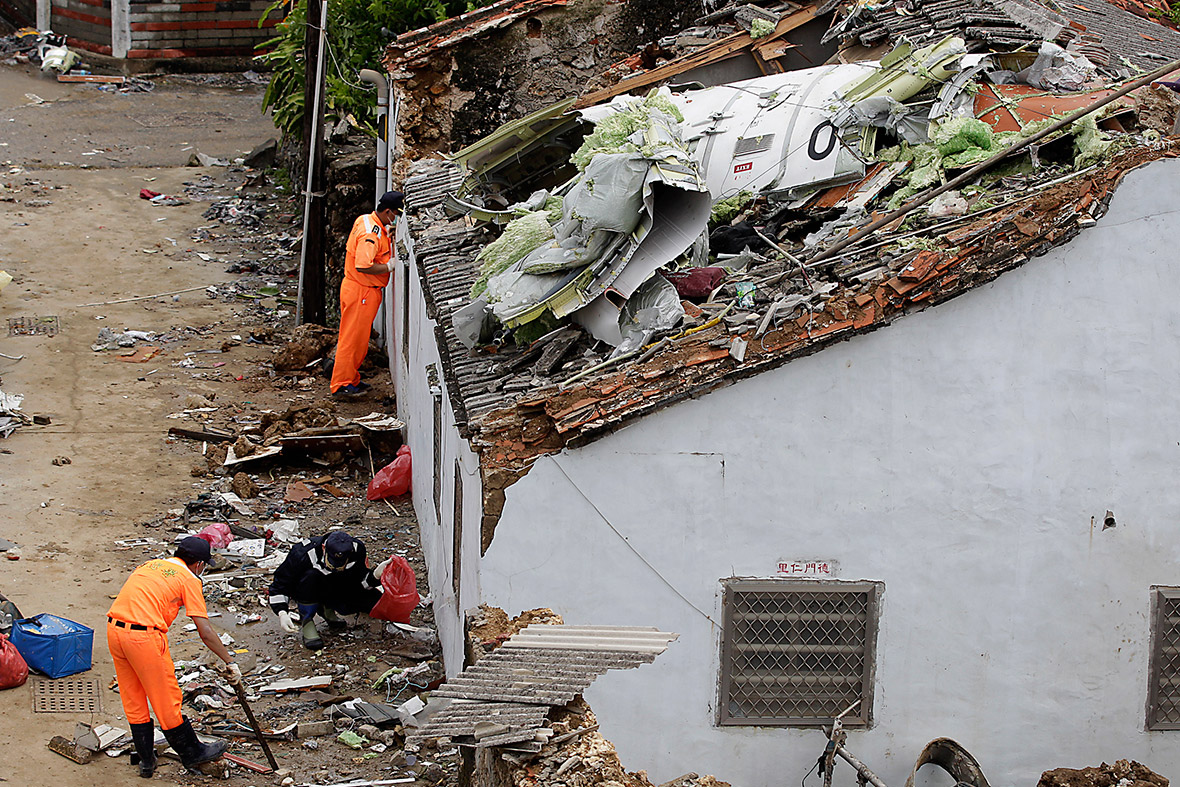

Crash of an ATR72-500 in Rome
Date & Time:
Feb 2, 2013 at 2032 LT
Registration:
YR-ATS
Survivors:
Yes
Schedule:
Pisa - Rome
MSN:
533
YOM:
1997
Flight number:
AZ1670
Crew on board:
4
Crew fatalities:
Pax on board:
46
Pax fatalities:
Other fatalities:
Total fatalities:
0
Captain / Total hours on type:
3351.00
Copilot / Total hours on type:
14
Aircraft flight hours:
24088
Circumstances:
The Rome-Fiumicino Airport Runway 25 was closed to trafic due to work in progress so the crew was vectored and cleared for a landing on runway 16L. The approach was completed in good visibility with strong crosswinds from 250° at 28 knots gusting to 41 knots and windshear. On the last segment, the aircraft lost height and impacted ground 567 metres short of runway 16L threshold. The aircraft bounced three times, lost its right main gear, slid for few dozen metres and came to rest in a grassy area some 1,780 metres past the runway threshold. All 50 occupants were rescued, among them seven were slightly injured. The aircraft was damaged beyond repair.
Probable cause:
The accident is due to the human factor. In particular, it was caused by an improper conduct of the aircraft by the PF (commander) during landing, not consistent with the provisions of the operator's manuals, in an environmental context characterized by the presence of significant criticality (presence of crosswind with values at the limit/excess those allowed for the ATR 72) and in the absence of an effective CRM.
The following factors may have contributed to the event:
- The failure to carry out the landing briefing, which, in addition to being required by company regulations, would have been an important moment of pooling and acceptance of information fundamental to the safety of operations.
- The maintenance of a V APP significantly higher than expected.
- The conviction of the commander (PF), deriving from his considerable general and specific experience on the aircraft in question, to be able to conduct a safe landing in spite of the presence of critical wind conditions for the type of aircraft.
- The considerable difference in experience between the commander and the first officer, which has reasonably prevented the latter from showing his critical capacity, thus rendering CRM techniques ineffective.
The following factors may have contributed to the event:
- The failure to carry out the landing briefing, which, in addition to being required by company regulations, would have been an important moment of pooling and acceptance of information fundamental to the safety of operations.
- The maintenance of a V APP significantly higher than expected.
- The conviction of the commander (PF), deriving from his considerable general and specific experience on the aircraft in question, to be able to conduct a safe landing in spite of the presence of critical wind conditions for the type of aircraft.
- The considerable difference in experience between the commander and the first officer, which has reasonably prevented the latter from showing his critical capacity, thus rendering CRM techniques ineffective.
Final Report:
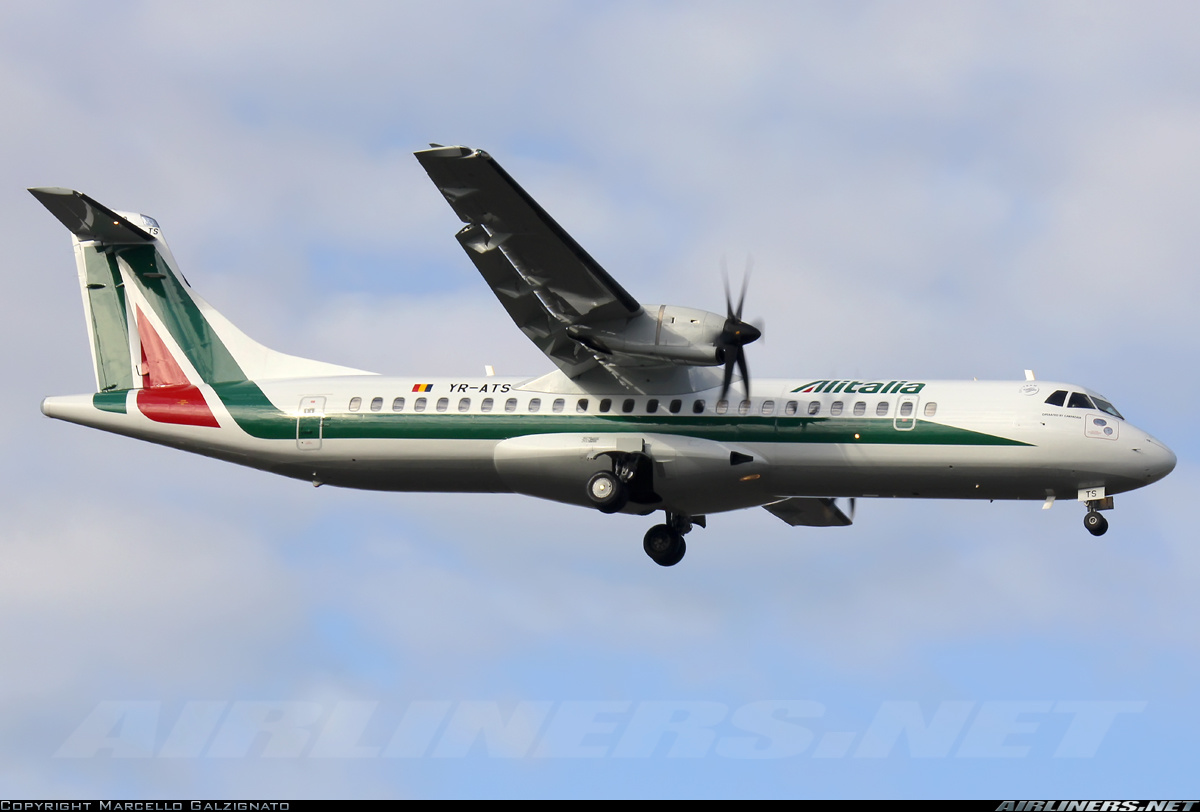
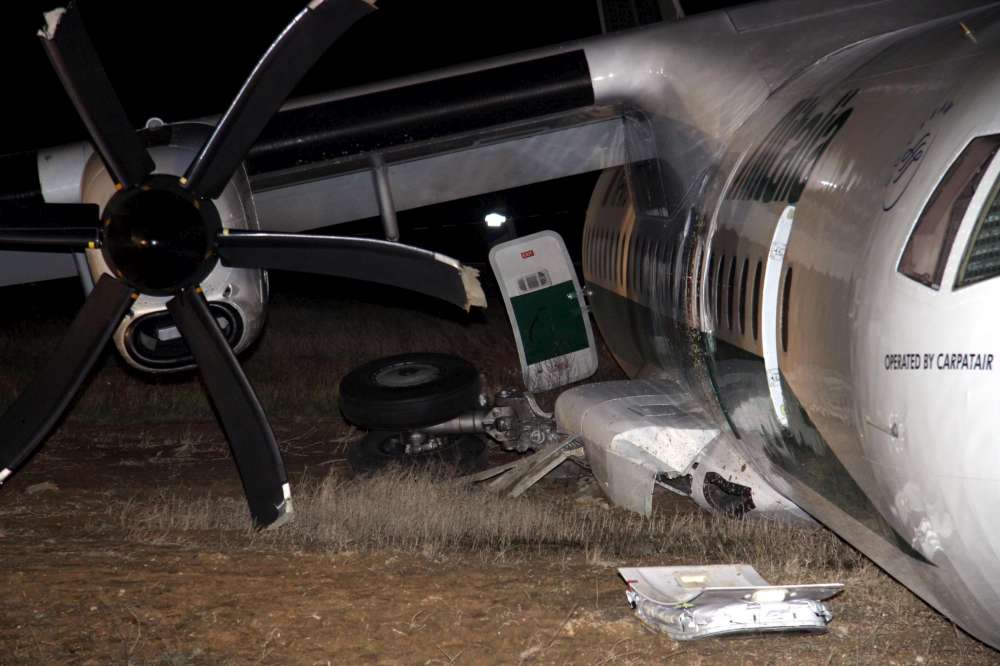
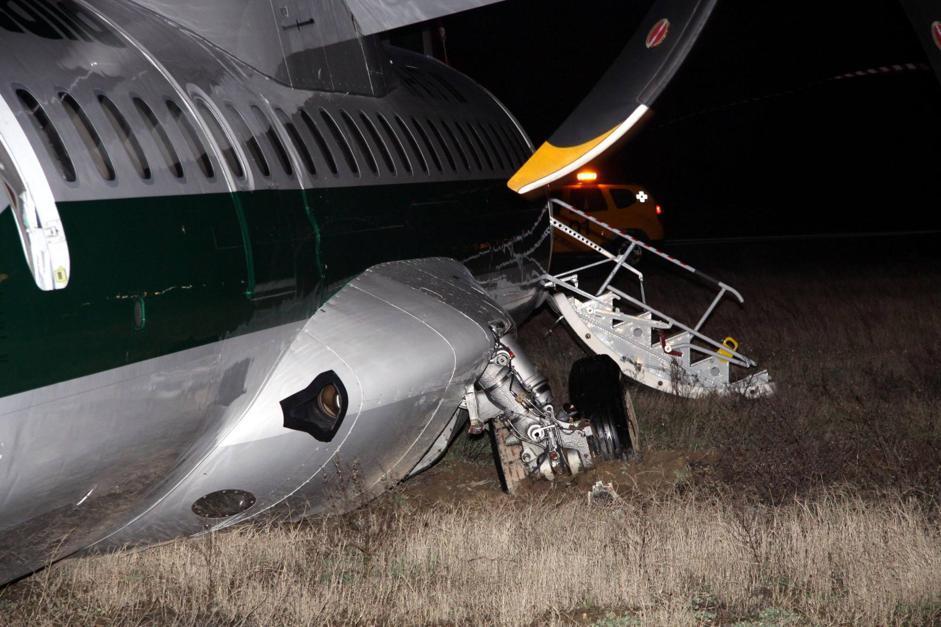
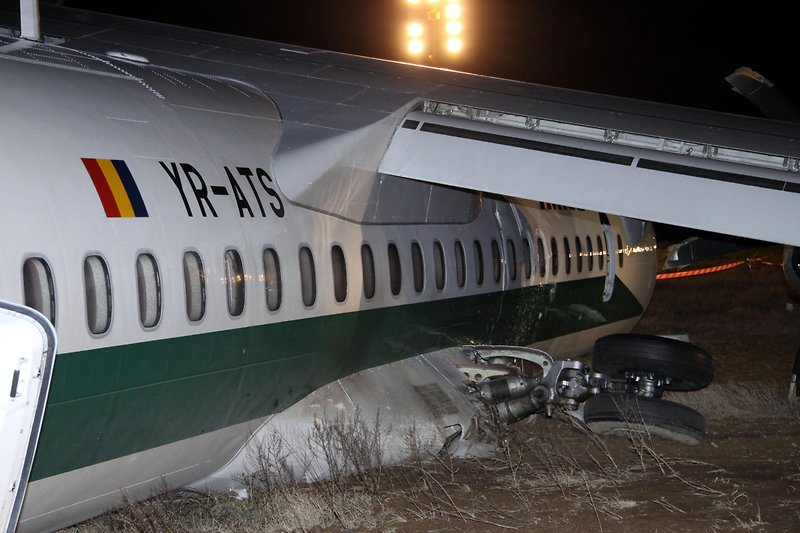
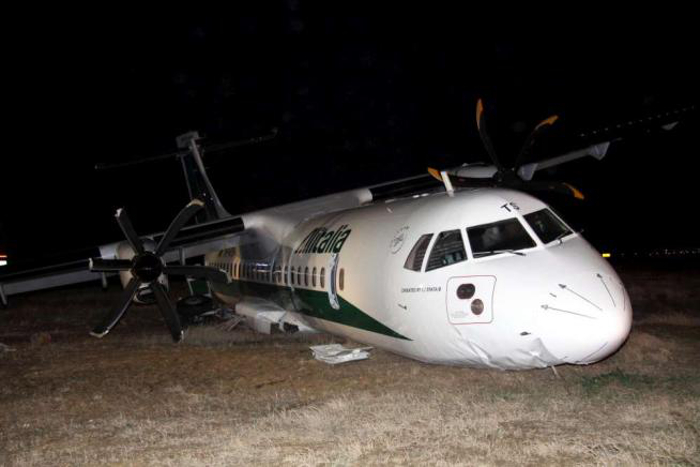
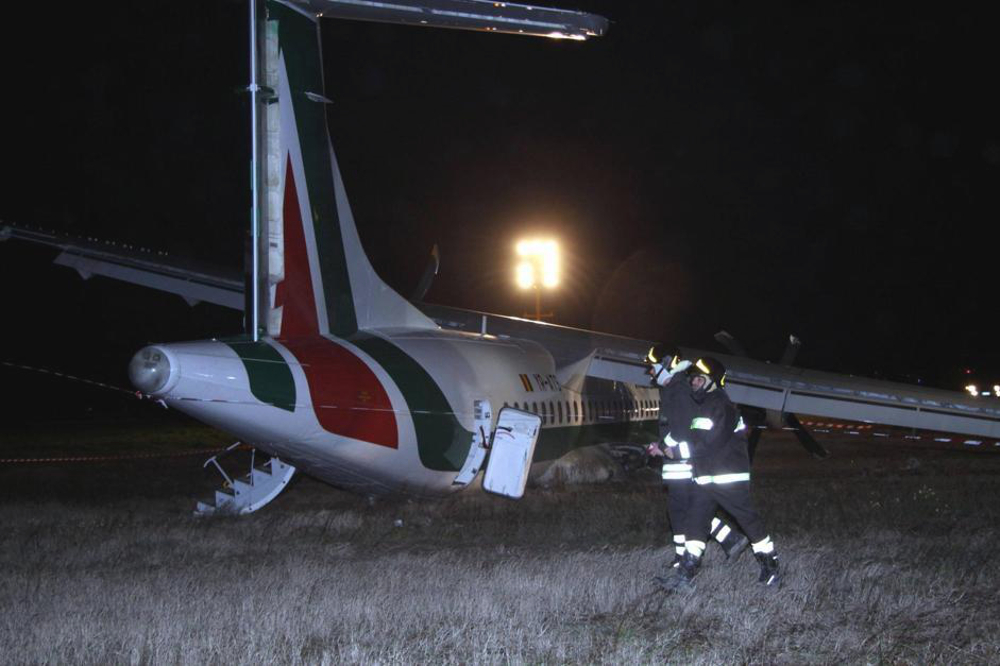
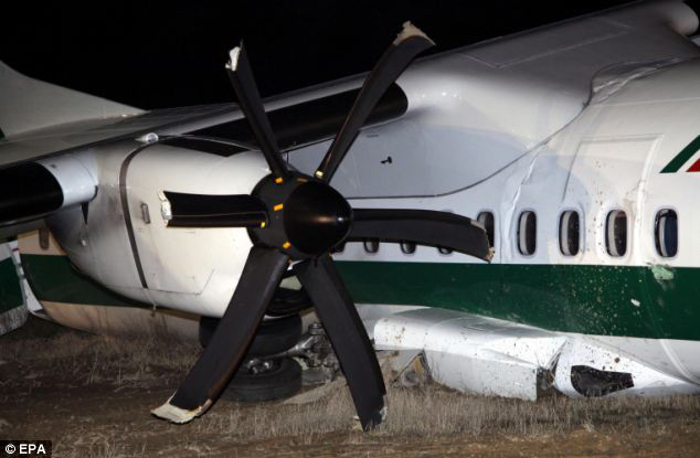
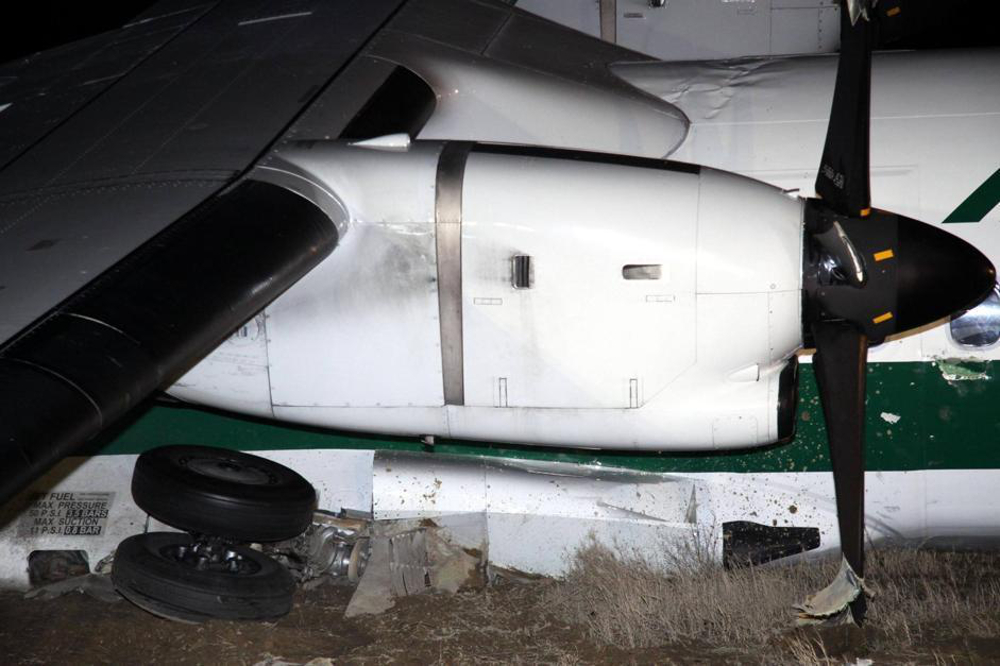

Crash of an ATR72-500 in Dhaka
Date & Time:
Apr 30, 2012 at 0851 LT
Registration:
60314
Survivors:
Yes
Schedule:
Bangkok - Dhaka
MSN:
881
YOM:
2009
Flight number:
KAT304
Crew on board:
7
Crew fatalities:
Pax on board:
8
Pax fatalities:
Other fatalities:
Total fatalities:
0
Circumstances:
After landing at Dhaka-Hazrat Shahjalal Airport, the twin engine aircraft deviated to the right and veered off runway. It collided with an embankment, lost its undercarriage and came to rest against a concrete wall. All 15 occupants were rescued, among them two passengers were slightly injured.
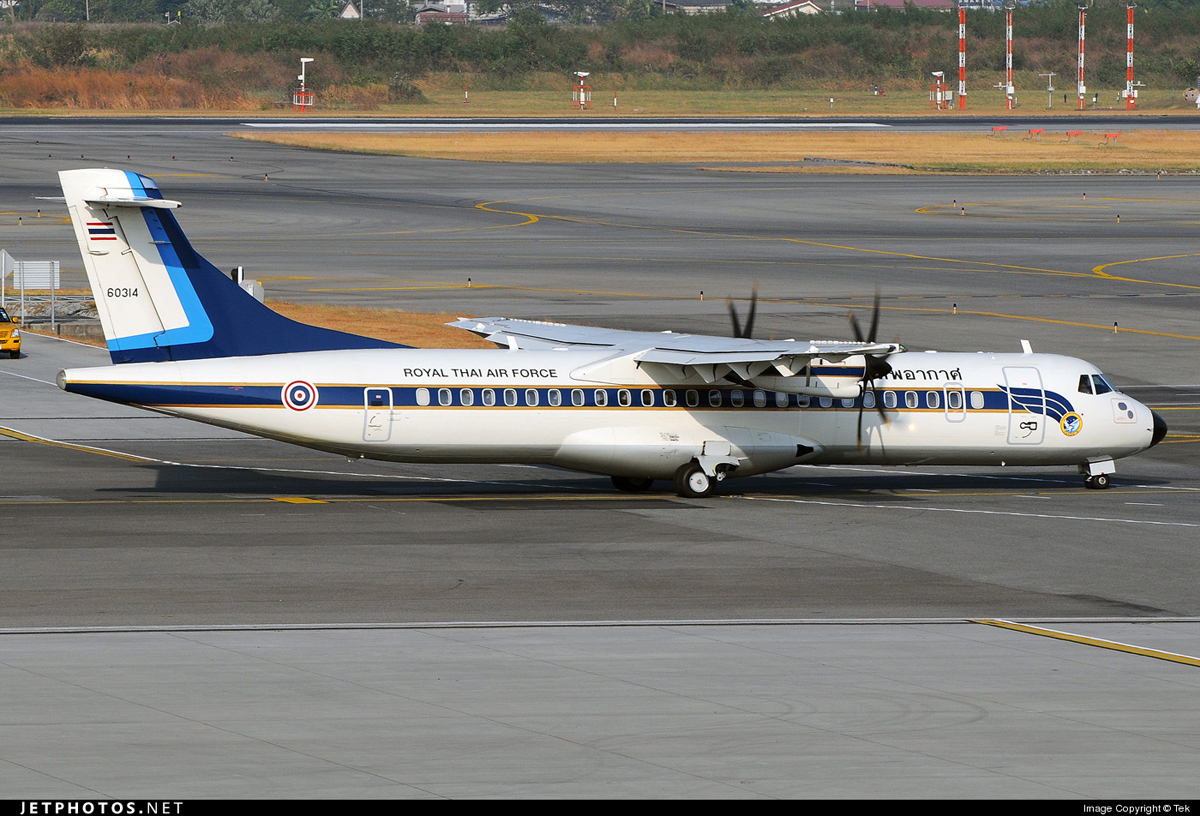
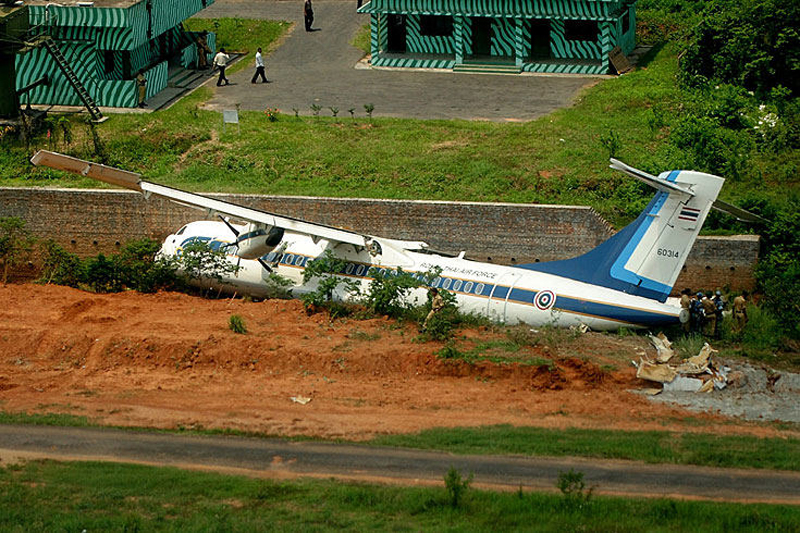
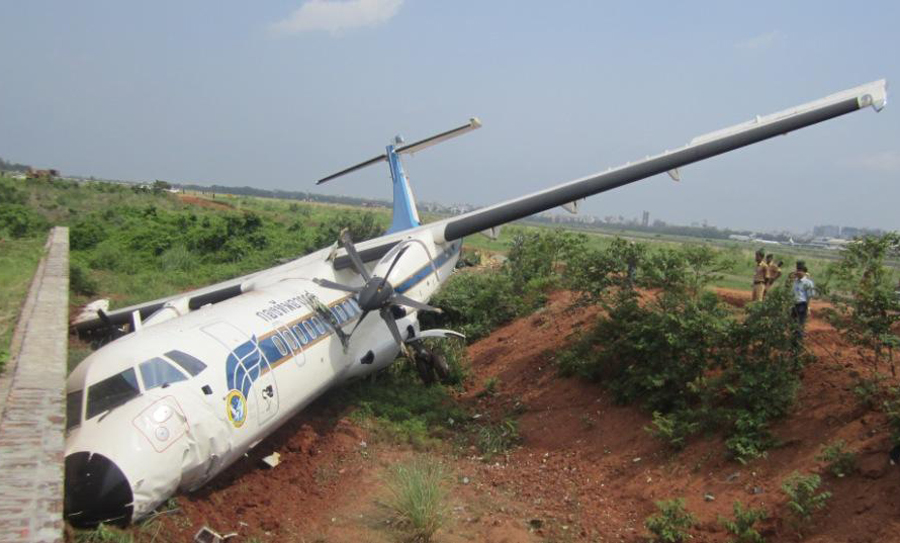
Crash of an ATR72-500 in Sandoway
Date & Time:
Feb 17, 2012 at 1030 LT
Registration:
XY-AIT
Survivors:
Yes
Schedule:
Heho - Sandoway
MSN:
543
YOM:
1998
Flight number:
KBZ243
Crew on board:
4
Crew fatalities:
Pax on board:
50
Pax fatalities:
Other fatalities:
Total fatalities:
0
Circumstances:
Following an uneventful flight from Heho, the aircraft bounced six times upon landing on runway 20. The final touchdown was reported some 1,500 feet past its threshold. The last bounce was very rough so the nose gear collapsed. The aircraft the skidded on runway and overran. On soft ground, both main landing gears collapsed and the aircraft hit a sand pile before coming to rest. while all 54 occupants escaped uninjured, the aircraft was damaged beyond repair as some blade of the right engine penetrated the fuselage after they hit the sand pile. It appears that the copilot was the PIC at the time of the accident.
